| Karkee Web Home Page | Officer's Main Page | W.E.O. Main Page | W.E.I.O. Main Page |
Web Equipment, Infantry Officers
Belts, Braces, & Straps
As with the 1916 pattern, the weave pattern of Mills Equipment for Officers was fine, involving singled warp threads, rather than the usual doubled threads.
BELT, WAIST, comprising
PIECE, SIDE, LEFT
PIECE, SIDE, RIGHT
STRAP, BACK ADJUSTMENT
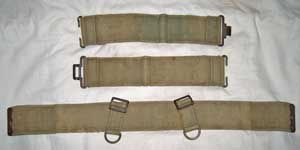 No details of the 1916 version are known, but for W.E.I.O., three sizes were offered, Small, Medium and Large. The Pieces, side were of constant length, the length of the Strap, back adjustment being varied. It is this Strap that has the size letter stamped on it. The major change concerned the way the Pieces, side, were connected to the Strap, back adjustment. It was Mills standard practice to use “C” hooks contained in a folded brass end-piece. These were first seen on Rifle slings, where the Army nomenclature was then Catches, brass. The later Army nomenclature, for the fitting used on Patt. ’37 Belts, was Hooks, brass, with tip, 2 1/4-in. These brass strap and belt tips served to protect the cut ends of the webbing, preventing fraying. Accordingly, Mills had used these to join their 1916 Belt sections. This left the brass fitting visible – the “naked” look – which was neither elegant, nor necessary. The 2.25-in. brass wire hooks were therefore fitted to the ends of the Side pieces with thin webbing patches, which covered and protected the cut ends of the belting.
No details of the 1916 version are known, but for W.E.I.O., three sizes were offered, Small, Medium and Large. The Pieces, side were of constant length, the length of the Strap, back adjustment being varied. It is this Strap that has the size letter stamped on it. The major change concerned the way the Pieces, side, were connected to the Strap, back adjustment. It was Mills standard practice to use “C” hooks contained in a folded brass end-piece. These were first seen on Rifle slings, where the Army nomenclature was then Catches, brass. The later Army nomenclature, for the fitting used on Patt. ’37 Belts, was Hooks, brass, with tip, 2 1/4-in. These brass strap and belt tips served to protect the cut ends of the webbing, preventing fraying. Accordingly, Mills had used these to join their 1916 Belt sections. This left the brass fitting visible – the “naked” look – which was neither elegant, nor necessary. The 2.25-in. brass wire hooks were therefore fitted to the ends of the Side pieces with thin webbing patches, which covered and protected the cut ends of the belting.
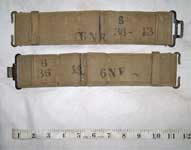
 The final change was a switch from a “loop and olivet” buckle to the new “hook and loop” form. This was patented in 1919 and used first on Patt. ’19 W.E., but its form continued in use and in differing materials in every Mills product thereafter, right up to Patt. ’58 W.E. and, in certain instances, beyond that and even into a quite different use. The latter will not form part of KW coverage, being an item of clothing, but post-1945, Stable Belts made an appearance, as a bit of “flash” to brighten up Barrack and Working Dress. More usually fastened with pairs of leather straps, some used a “hook and loop” buckle. The Belt shown left and above is maker marked "M.E. Co." and dated 1936. It is also unit marked to the 6th Northumberland Fusiliers. From the Chris Pollendine Collection, photographs © Chris Pollendine 2010.
The final change was a switch from a “loop and olivet” buckle to the new “hook and loop” form. This was patented in 1919 and used first on Patt. ’19 W.E., but its form continued in use and in differing materials in every Mills product thereafter, right up to Patt. ’58 W.E. and, in certain instances, beyond that and even into a quite different use. The latter will not form part of KW coverage, being an item of clothing, but post-1945, Stable Belts made an appearance, as a bit of “flash” to brighten up Barrack and Working Dress. More usually fastened with pairs of leather straps, some used a “hook and loop” buckle. The Belt shown left and above is maker marked "M.E. Co." and dated 1936. It is also unit marked to the 6th Northumberland Fusiliers. From the Chris Pollendine Collection, photographs © Chris Pollendine 2010.
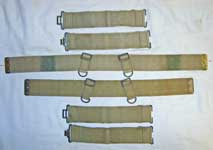
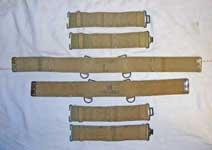 The photos at left show Large (above) and Medium (below) Belts. The Side pieces are the same for both sizes, but the large Back adjustment strap is 5-inches longer than the medium Strap. Both Belts are from the Karkee Web Collection, and are maker marked "M.E. Co." The Large Belt is dated 1930, whilst the Medium one is dated 1927.
The photos at left show Large (above) and Medium (below) Belts. The Side pieces are the same for both sizes, but the large Back adjustment strap is 5-inches longer than the medium Strap. Both Belts are from the Karkee Web Collection, and are maker marked "M.E. Co." The Large Belt is dated 1930, whilst the Medium one is dated 1927.
ATTACHMENT, BRACE (Issues 1 to 4)

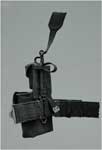
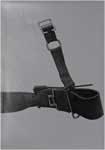 When we started working on this section, we had no idea that Brace attachments would prove this complex. Official M.E.Co. photos of their upgraded 1919 form show the 1916 form of attachment was to have been used. This 1st Issue had slightly tapered sides, with a small dee formed exactly in line with the sides. This gave dees of two sizes, that at the rear of the Belt being of the standard Mills size. This is shown clearly in the photo at left, where the new addition of a Sword frog shows its ¾-inch strap is an uncomfortable fit in the front dee. The lower, short side of the frame was indented, as before, to locate the end of the pin. The photo at left shows the initial stage of fitting the gateleg frame to the belt. That on the right shows how the Brace was threaded through, tying the Pouch loop back to the circular link.
When we started working on this section, we had no idea that Brace attachments would prove this complex. Official M.E.Co. photos of their upgraded 1919 form show the 1916 form of attachment was to have been used. This 1st Issue had slightly tapered sides, with a small dee formed exactly in line with the sides. This gave dees of two sizes, that at the rear of the Belt being of the standard Mills size. This is shown clearly in the photo at left, where the new addition of a Sword frog shows its ¾-inch strap is an uncomfortable fit in the front dee. The lower, short side of the frame was indented, as before, to locate the end of the pin. The photo at left shows the initial stage of fitting the gateleg frame to the belt. That on the right shows how the Brace was threaded through, tying the Pouch loop back to the circular link.

 The examples shown left are from the Nick Wall Collection. Nick's W.E.I.O. set is a mixture of Great War and later officers' web equipment. His Brace attachments are M.E. Co. marked, but are undated, so they could be either 1916 pattern, or 1st issue post-war pattern. Photos © Nick Wall 2009.
The examples shown left are from the Nick Wall Collection. Nick's W.E.I.O. set is a mixture of Great War and later officers' web equipment. His Brace attachments are M.E. Co. marked, but are undated, so they could be either 1916 pattern, or 1st issue post-war pattern. Photos © Nick Wall 2009.
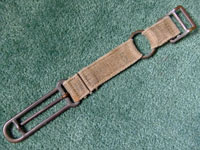 This example, from the Martin Clewlow Collection, is clearly 1st issue W.E.I.O. It is maker marked "M.E. Co." and dated 1925.
This example, from the Martin Clewlow Collection, is clearly 1st issue W.E.I.O. It is maker marked "M.E. Co." and dated 1925.
![]()
![]() A 2nd Issue Brace attachment was then introduced, with a completely new form of frame. These were now parallel-sided and with a larger dee. The internal measurement of the dee now corresponded to the outside width of the gateleg frame. The same frame, without a dee, was also used for Patt. ’19 W.E. Which came first is not known. The 2nd issue example at left has a straight, not cranked, hinged pin, like the Brace attachments for Patt. '19. This Brace attachment is maker marked "M.E. Co." but undated, and comes from a set dated 1927. This set is from the Collection of Jerry Lee, proprietor of the What Price Glory. Photos © Jerry Lee 2010.
A 2nd Issue Brace attachment was then introduced, with a completely new form of frame. These were now parallel-sided and with a larger dee. The internal measurement of the dee now corresponded to the outside width of the gateleg frame. The same frame, without a dee, was also used for Patt. ’19 W.E. Which came first is not known. The 2nd issue example at left has a straight, not cranked, hinged pin, like the Brace attachments for Patt. '19. This Brace attachment is maker marked "M.E. Co." but undated, and comes from a set dated 1927. This set is from the Collection of Jerry Lee, proprietor of the What Price Glory. Photos © Jerry Lee 2010.

 A surprise addition to the sequence are the pair shown here at left, from the Karkee Web Collection. They are maker marked "M.E. Co.", are undated, but they are from a set dated 1930. This 3rd Issue does not follow the sequence of modifications to Patt. ’19 W.E., where its cranked pin was introduced at the same time as the circular link was changed to a square one. However, this example has a cranked pin, but the link is still circular. With no documentation to go on, it is speculated that Mills were using up stocks of circular links. The change from circular to a square link was an example of “lean manufacturing” to facilitate easier production. A circle has to be formed from brass wire stock, whereas a square is blanked, in one operation, by a double-action press.
A surprise addition to the sequence are the pair shown here at left, from the Karkee Web Collection. They are maker marked "M.E. Co.", are undated, but they are from a set dated 1930. This 3rd Issue does not follow the sequence of modifications to Patt. ’19 W.E., where its cranked pin was introduced at the same time as the circular link was changed to a square one. However, this example has a cranked pin, but the link is still circular. With no documentation to go on, it is speculated that Mills were using up stocks of circular links. The change from circular to a square link was an example of “lean manufacturing” to facilitate easier production. A circle has to be formed from brass wire stock, whereas a square is blanked, in one operation, by a double-action press.

 The above forced the Attachments at left to a 4th Issue status. This pair are maker marked "M.E. Co." and are undated, but have the square link that was introduced on Patt. ’19 W.E. Attachments in 1929. They are from the 1936 dated set, marked to the 6th Northumberland Fusiliers, in the Chris Pollendine Collection. Photos © Chris Pollendine.
The above forced the Attachments at left to a 4th Issue status. This pair are maker marked "M.E. Co." and are undated, but have the square link that was introduced on Patt. ’19 W.E. Attachments in 1929. They are from the 1936 dated set, marked to the 6th Northumberland Fusiliers, in the Chris Pollendine Collection. Photos © Chris Pollendine.
BRACE, left, with loop
BRACE, right
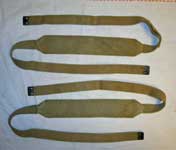
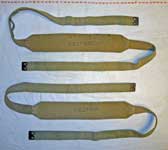 These remained almost unchanged from their 1916 form, reduction-woven with a 2-inch shoulder flare. Taking dimensions from the Patt. ’19 version, they were 50 1/2-inches long, 2 1/2-inches longer than Patt. ’37 Normal Braces. The pair shown at left are maker marked "M.E. Co." and dated 1930. From the Karkee Web Collection.
These remained almost unchanged from their 1916 form, reduction-woven with a 2-inch shoulder flare. Taking dimensions from the Patt. ’19 version, they were 50 1/2-inches long, 2 1/2-inches longer than Patt. ’37 Normal Braces. The pair shown at left are maker marked "M.E. Co." and dated 1930. From the Karkee Web Collection.
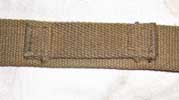 The crossing loop was simplified and not diagonally stitched to give the original, idiot-proof cross-over of 1916. The Brace shown in this detail is maker marked "M.E. Co." and dated 1936. From the Chris Pollendine Collection, photograph © Chris Pollendine 2010.
The crossing loop was simplified and not diagonally stitched to give the original, idiot-proof cross-over of 1916. The Brace shown in this detail is maker marked "M.E. Co." and dated 1936. From the Chris Pollendine Collection, photograph © Chris Pollendine 2010.
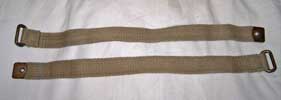 Fitted with a brass loop at one end, it allowed the Strap to be attached to the Brace attachment link, when doubled on itself. The Strap, haversack, provided complete support for the Haversack, its own transverse strap serving only to stop the upper edge of the Haversack falling backwards. These Straps are neither maker marked nor dated, but they came attached, likely from new, to a W.E.I.O. Haversack maker marked "M.E. Co." and dated 1938. From the Chris Pollendine Collection, photograph © Chris Pollendine 2010.
Fitted with a brass loop at one end, it allowed the Strap to be attached to the Brace attachment link, when doubled on itself. The Strap, haversack, provided complete support for the Haversack, its own transverse strap serving only to stop the upper edge of the Haversack falling backwards. These Straps are neither maker marked nor dated, but they came attached, likely from new, to a W.E.I.O. Haversack maker marked "M.E. Co." and dated 1938. From the Chris Pollendine Collection, photograph © Chris Pollendine 2010.
 A Fitting Instruction poster, published by Mills, clearly illustrates a Mess tin strap fitted in the flap loops, but not a Cover, mess tin. The mess tin at this time was still the Tin, mess, D.S., for Dismounted Services, i.e. the D-section form dating back to Napoleonic times. A wide range of mess tins were available for officers to purchase, which could include circular types, including up-market versions of the Tin, mess, M.S., for Mounted Services. These tended to be sold with a leather strap to keep Body and Lid together, although suitable Covers were available. KW have not been able to identify a surviving example of this strap, which was 22 x ¾-inches. The picture at left, showing the Strap, mess tin, fitted to the two horizontal loops (of 1-inch strap accommodation) on the flap of the W.E.I.O.Pack, is from the 1919 Mills Web Officers' Equipment catalogue.
A Fitting Instruction poster, published by Mills, clearly illustrates a Mess tin strap fitted in the flap loops, but not a Cover, mess tin. The mess tin at this time was still the Tin, mess, D.S., for Dismounted Services, i.e. the D-section form dating back to Napoleonic times. A wide range of mess tins were available for officers to purchase, which could include circular types, including up-market versions of the Tin, mess, M.S., for Mounted Services. These tended to be sold with a leather strap to keep Body and Lid together, although suitable Covers were available. KW have not been able to identify a surviving example of this strap, which was 22 x ¾-inches. The picture at left, showing the Strap, mess tin, fitted to the two horizontal loops (of 1-inch strap accommodation) on the flap of the W.E.I.O.Pack, is from the 1919 Mills Web Officers' Equipment catalogue.
 This Mess tin strap is from the 1916 pattern of W.E.O., but we assume that the same strap for W.E.I.O. would be identical. It is maker marked "M.E. Co." and dated 1917. From the Paul Hannon Collection, photographs © Paul Hannon 2010.
This Mess tin strap is from the 1916 pattern of W.E.O., but we assume that the same strap for W.E.I.O. would be identical. It is maker marked "M.E. Co." and dated 1917. From the Paul Hannon Collection, photographs © Paul Hannon 2010.

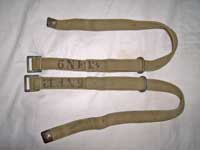 These have been noted, associated with a set of W.E.I.O.. They are ¾-inch webbing, longer versions of the Strap, supporting, but with a buckle at one end and a loop at the other. A secondary strap is stitched-on, a belt’s width from the looped end. The running end of the secondary strap is passed through the brass loop, thus forming a loose belt loop and making it captive on the belt. A pair of these served to attach a rolled Great Coat, Raincoat, or Groundsheet Cape in the small of the back, if the Rucksack was not being worn. It is interesting to note that Mills stencilling is effectively on the outside of the strap, albeit this is hidden when fitted. They are maker marked "M.E. Co." and dated 1936. It is speculated that these straps replaced the Coat carrier, between 1926 and 1936. From the Chris Pollendine Collection, photographs © Chris Pollendine 2010.
These have been noted, associated with a set of W.E.I.O.. They are ¾-inch webbing, longer versions of the Strap, supporting, but with a buckle at one end and a loop at the other. A secondary strap is stitched-on, a belt’s width from the looped end. The running end of the secondary strap is passed through the brass loop, thus forming a loose belt loop and making it captive on the belt. A pair of these served to attach a rolled Great Coat, Raincoat, or Groundsheet Cape in the small of the back, if the Rucksack was not being worn. It is interesting to note that Mills stencilling is effectively on the outside of the strap, albeit this is hidden when fitted. They are maker marked "M.E. Co." and dated 1936. It is speculated that these straps replaced the Coat carrier, between 1926 and 1936. From the Chris Pollendine Collection, photographs © Chris Pollendine 2010.
Rog Dennis, updated March, 2017